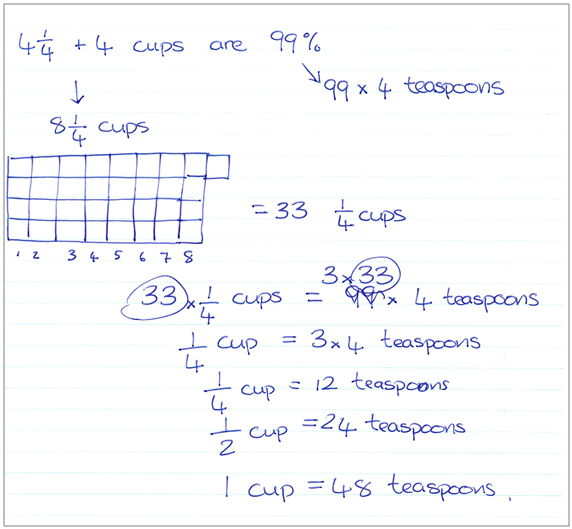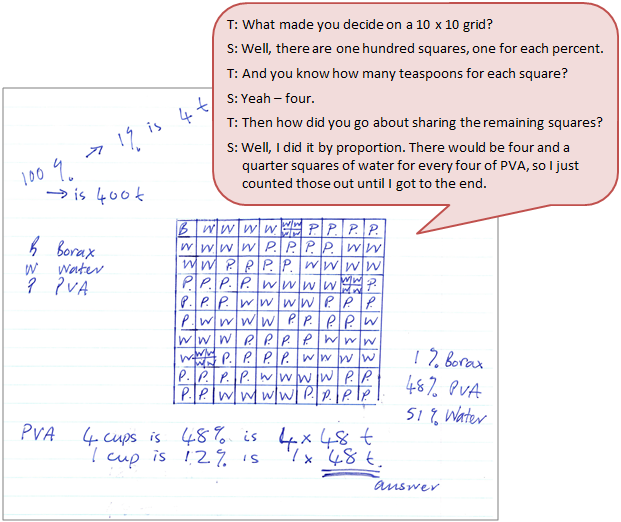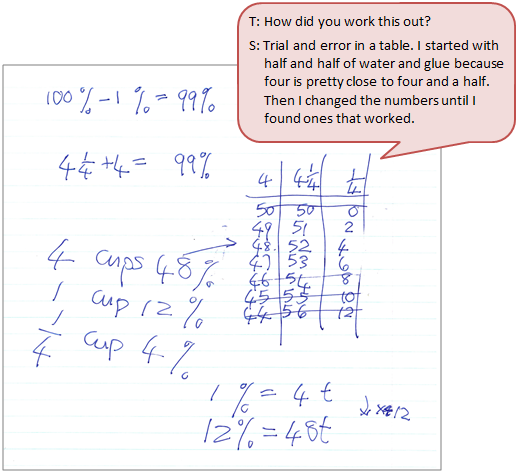Making Flubber
The purpose of this activity is to engage students in using fractions, proportions and percentages to solve a problem.
This activity assumes the students have experience in the following areas:
- Expressing a percentage as fraction with 100 as the denominator.
- Finding equivalent fractions.
- Expressing proportions as fractions, e.g., In the ratio 2:3 the part-whole fractions are 2/5 and 3/5.
- Finding fractions of amounts, e.g., ¾ x 28 kg = 21 kg.
- Expressing fractions as percentages, e.g., 3/5 = 60%.
The problem is sufficiently open ended to allow the students freedom of choice in their approach. It may be scaffolded with guidance that leads to a solution, and/or the students might be given the opportunity to solve the problem independently.
The example responses at the end of the resource give an indication of the kind of response to expect from students who approach the problem in particular ways.

A class wants to make Flubber.
Their teacher gives them a recipe which uses 4 1/4 cups of water, 4 cups of PVA glue and 4 teaspoons of Borax. She says that they have all the ingredients but only a teaspoon for measuring.
The teacher tells them that Borax makes up 1% of the final mixture, so they should be able to work out how many teaspoons of water and PVA glue to add.
How can the class use this information to work out how many teaspoons in a cup?
The following prompts illustrate how this activity can be structured around the phases of the Mathematics Investigation Cycle.
Make sense
Introduce the problem. Allow students time to read it and discuss in pairs or small groups.
- Do I understand the situation and the words? (Students may need support to isolate the important information from the words.)
- What are the important words and symbols? (The mixture is made up of 4 ¼ cups of water, 4 cups of PVA and 1% borax. The amounts do not have the same reference unit. 4 teaspoons is 1% of the mixture (borax).)
- What will my solution look like? (The solution will be the number of teaspoons in a cup with supporting evidence.)
Plan approach
Discuss ideas about how to solve the problem. Emphasise that, in the planning phase, you want students to say how they would solve the problem, not to actually solve it.
- What are the maths skills I need to work this out? (Students need to recognise that rates and ratios are involved and strategies that can be used which are generally multiplicative.)
- What might be my first step? Where will that step lead to? What will I know?
- What could the solution be? What is a sensible estimate for the number of teaspoons in a cup?
- How will I organise my working in a systematic way, so I ease memory load and keep track of the information? (Ratio tables are very useful for solving problems like this.)
- What tools (digital or physical) could help my investigation? (Calculators will be useful to ease the burden of calculations and deal with conversions between units.)
- What strategies might I use? Can I draw or sketch the situation? (Some diagrammatic representation of the whole mixture is very useful.)
Take action
Allow students time to work through their strategy and find a solution to the problem.
- Have I shown my workings in a step-by-step way that will be clear to others?
- Does my answer seem correct? Is it close to my estimation?
- How could I make sure that I haven’t missed anything?
- How does my strategy compare to those used by others?
- Is there solution the same or different to mine? Why might that be?
- Is there another possible way to solve the problem? Which way is most efficient?
Convince yourself and others
Allow students time to check their answers and then either have them pair share with other groups or ask for volunteers to share their solution with the class.
- What is the solution? Does it include the number of teaspoons that fill a cup and clear justification of how the number was found?
- How would I convince someone else I am correct?
- Could I have solved the problem in a more efficient way?
- What connections can I see to other situations, why would this be? (Conversion among measures is an important aspect of many real-life problems.)
- Which ideas or tools worked well in my investigation?
- What could I try differently next time? What maths do I need to learn?
Examples of work
Work sample 1
The student uses their knowledge of quarters to create an image for the whole mixture. They rename 4 and 4 ¼ as 33 quarters and relate that to 99%, since the borax is 1% of the mixture. Using a table, the student creates a pattern of equivalent measures to solve the problem.
Click on the image to enlarge it. Click again to close.
Work sample 2
The student uses the unit rate that 1% of the mixture equals 4 teaspoons. They recognise that PVA (4 cups) makes up 48% of the mixture so each cup equals 12% of the mixture. Using the unit rate, they calculate 12 x 4 = 48 teaspoons per cup.


